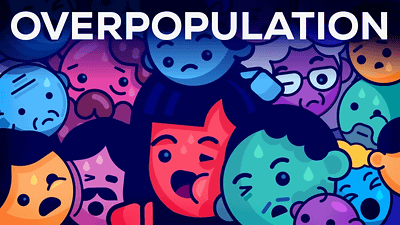The end of South Korea: A falling birth rate will bring about a collapse of the population, economy, society, culture, and everything else.

South Korea is home to several global companies such as Samsung, LG, and Hyundai, but
SOUTH KOREA IS OVER - YouTube
'This may sound shocking, but South Korea will soon begin to collapse in every respect: demographically, economically, socially, culturally and militarily,' Kurzgesagt begins with some impactful words.

The reason is that 'South Korea has been facing a birth rate crisis unprecedented in human history for the past few decades,' and according to Kurzgesagt, South Korea has reached a point of no return.

'By 2060, the Korea we know and love today will no longer exist,' but how will that collapse unfold, and why is it nearly impossible to stop?

The main cause of South Korea's collapse is a falling birth rate. To stabilize the population, each woman needs to have about 2.1 children. In fact, in the 1950s, Korean women had about six children each.

However, in the 1980s, the birth rate fell below 2 children per woman, and by 2023, it had fallen to a record low of 0.72 children per woman. The birth rate is especially low in the capital, Seoul, where it has fallen to around 0.55 children per woman.

What does this low birth rate mean in the real world? If the birth rate continues at this rate, then for every 100 Koreans, the number of children born in the next generation will be 36, then in the next generation it will be 13, then in the next generation it will be 5. So in just four generations, every 100 Koreans will have just 5 children.

If we look at South Korea's population pyramid for 2024, we can see that this phenomenon is already underway: for every four 50-year-old Koreans, there will be just one one-year-old child.

Despite the long history of low birth rates, the impact of this has not been very noticeable until now. This is because South Korea's total population is at an all-time high at the time of writing, and its working population and GDP are both growing.

However, Kurzgesagt describes population decline as 'like the sound of a freight train coming from afar,' and when you think it's getting closer, it's already right in front of you. South Korea is about to be hit by that freight train.

Let's fast forward 35 years to 2060 and see what kind of country South Korea will be.

For population projections, UN estimates are most often used.

The UN presents three scenarios (low birth rate, intermediate birth rate, and high birth rate), but South Korea's past data shows that even the intermediate birth rate is too optimistic. In fact, South Korea's birth rate fell by 8% between 2022 and 2023. Therefore, this time Kurzgesagt simulates what will happen to South Korea if the years go by with the most realistic 'low birth rate'.
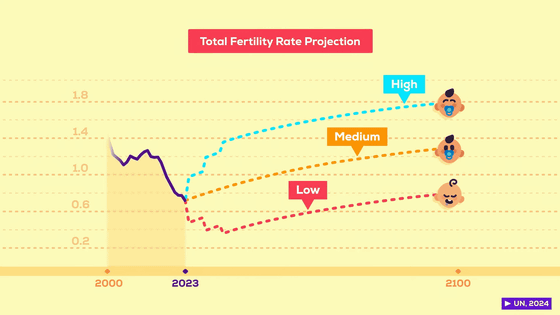
South Korea's population pyramid in 2060 is as follows.

The population would fall by 30%, shrinking from 51.7 million to 35.8 million, meaning that about 16 million people would disappear.
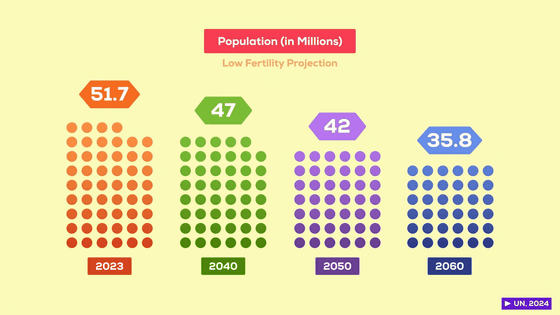
This makes South Korea the oldest country in history, with one in two people over 65. Fewer than one in ten people are under the age of 25. In addition, there is only one child under the age of five in every 100 people.

Kurzgesagt describes a future in which people will wake up in the morning to quiet, childless streets, many cities in ruins, elderly people left behind, care homes overcrowded and few workers to support society.

What will happen after the population decline is 'economic collapse.'

As of 2023, 40% of South Korea's population aged 65 and over will be classified as poor. However, by 2060, this figure will be so bad that it will seem 'still better.'

At the time of writing, South Korea's pension fund is the largest in the world, with approximately $730 billion (approximately 110 trillion yen).

However, pension funds are expected to stop growing in the 2040s and run out in the 2050s, meaning that by 2060 the working generation will have no choice but to support the elderly.

To maintain the pension system, we need at least two to three workers for every elderly person.

However, by 2060, the number of workers supporting one elderly person is expected to be around 1.01.
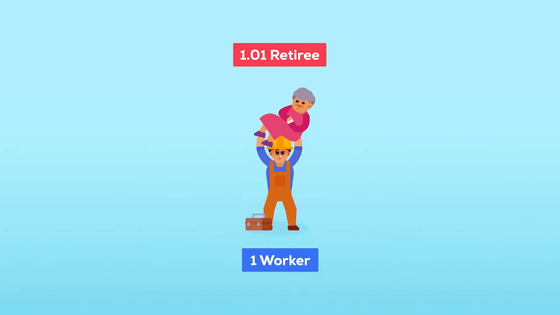
As a result, workers will be unable to support the elderly, further increasing poverty. And many of the elderly will have no choice but to work. 'But if the Korean economy had collapsed in the first place, there may not even be jobs,' Kurzgesagt said.

In the first place, it seems that the size of South Korea's economy depends mainly on the size of its working population.

As of 2023, South Korea's working population will be approximately 37 million and its GDP will be approximately $1.7 trillion (approximately 250 trillion yen).

However, by 2060, the working population is expected to fall by more than half, to around 17 million.
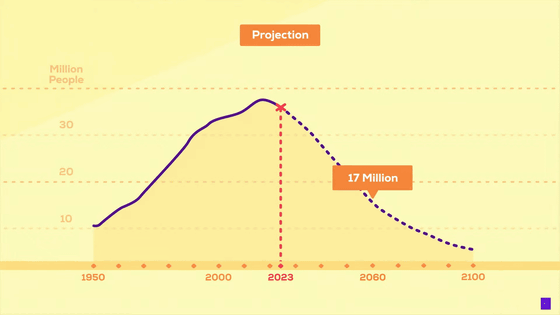
Technological advances may improve productivity per capita, but given the declining population, South Korea's GDP is expected to peak in the 2040s and then decline, meaning that South Korea is likely to become a 'country in perpetual recession.'

Furthermore, Kurzgesagt argues that population decline will also lead to 'social and cultural collapse.'

According to a survey, 20% of South Korea's population already lives alone, and 20% of the population said they have no close friends or family.

By 2060, these figures are predicted to worsen, with 50% of Koreans over 70 years old expected to have no siblings and 30% expected to have no children.
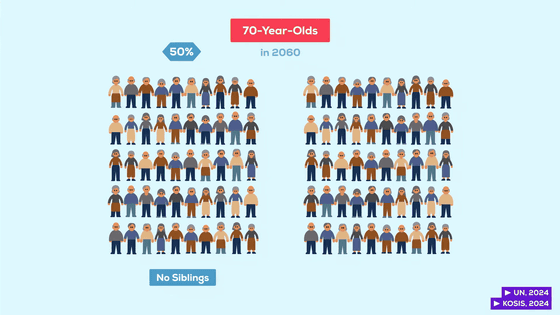
In addition, young people aged 25 to 35 will account for only 5% of the population. As a result, young people will have less interaction with each other, and 'people's loneliness will accelerate even more,' Kurzgesagt said.

Furthermore, Korean culture is expected to decline. In 2000, there were nearly 20 million young people between the ages of 25 and 45, who created Korean culture such as K-POP, TV dramas, and food.

However, the number of young people aged 25 to 45 is expected to fall to 5.6 million by 2060. As a result, 'there will be almost no one to carry on culture,' Kurzgesagt points out.

South Korea's population collapse is not a 'future story' but a reality that has already begun. 'If we do not face up to this problem and are unable to create a society in which young people want to have children, then South Korea's future is bleak. The freight train of population decline is unstoppable and is now approaching South Korea,' Kurzgesagt said.
Related Posts:
in Video, Posted by logu_ii






